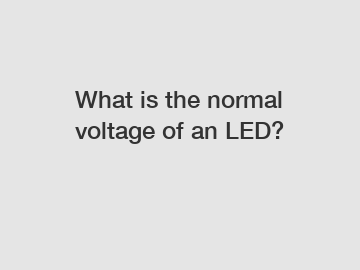What is the normal voltage of an LED?
What is the normal voltage of an LED?
LEDs, or Light Emitting Diodes, have become an integral part of our modern world. They are used in a wide range of applications, from lighting up our homes and cars to displaying information on electronic devices. However, have you ever wondered what the normal voltage of an LED is? In this article, we will explore the topic and provide you with the information you need.
Understanding LED Voltage.

To comprehend the normal voltage of an LED, let's first understand what an LED is and how it works. A Light Emitting Diode is a semiconductor device that emits light when an electric current flows through it. Unlike traditional incandescent bulbs, LEDs are solid-state devices with no moving or fragile parts. They are highly efficient, durable, and long-lasting.
When an LED is connected to a power source, such as a battery or a power supply, it requires a certain amount of voltage to start conducting electricity and emit light. This voltage is commonly referred to as the forward voltage or Vf of the LED. Each type of LED has a specific Vf value, which is determined by its materials and design.
The Normal Voltage Range.
While the Vf value varies across different types of LEDs, most common LEDs have a forward voltage in the range of 1.8 to 3.3 volts. It is important to note that this is the typical operating voltage and not an absolute value. Some specialty LEDs, such as high-power LEDs used in lighting applications, may have a higher forward voltage, often ranging from 3.2 to 4.0 volts.
Factors Affecting LED Voltage.
Several factors can influence the normal voltage of an LED. The most significant factor is the color of the LED. Different colors of LEDs have different forward voltage requirements. For example, red and amber LEDs generally have a forward voltage around 1.8 to 2.1 volts, while blue and white LEDs typically have a higher forward voltage of 3.0 to 3.3 volts.
Another factor affecting LED voltage is the current flowing through it. LEDs have a current-voltage relationship, meaning the forward voltage can vary depending on the amount of current passing through the LED. The forward voltage may increase slightly with higher current levels and decrease at lower current levels.
Using the Correct Voltage.
To ensure the longevity and proper functioning of LEDs, it is crucial to use the correct voltage. Applying voltage higher than the rated forward voltage can damage the LED and significantly reduce its lifespan. On the other hand, using a voltage lower than the forward voltage might not provide enough current for the LED to emit light or result in dim illumination.
To determine the appropriate voltage for an LED, it is recommended to consult the manufacturer's datasheet or specifications. These documents provide detailed information about the LED's optimal operating conditions, including the forward voltage. When designing circuits or choosing power sources for LED applications, it is essential to consider the forward voltage requirements of the specific LED being used.
Conclusion.
In conclusion, the normal voltage of an LED, or the forward voltage, typically ranges from 1.8 to 3.3 volts for most common LEDs. The actual voltage required may vary depending on factors such as the LED color and the current passing through it. Using the correct voltage is crucial to ensure the optimal performance and longevity of LEDs. If you have any further questions or need assistance with LED voltage or any related topic, please do not hesitate to contact us.
If you are looking for more details, kindly visit smd led pcb, what is the difference between led and cob led, cob led chip temperature.
199
0
0


Comments
All Comments (0)